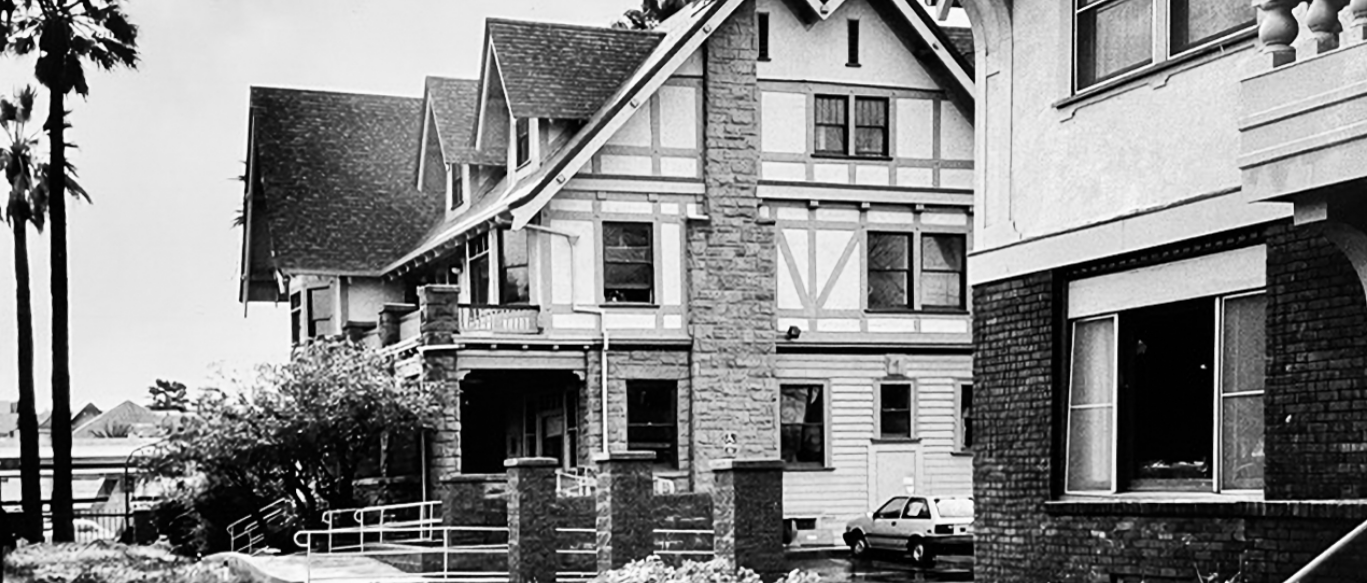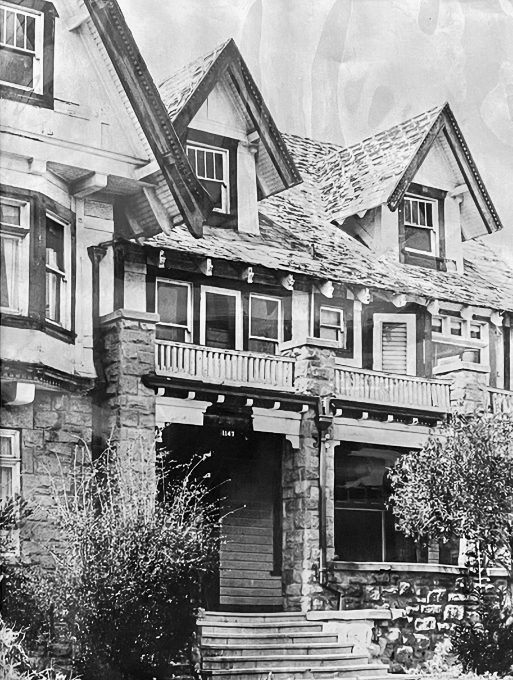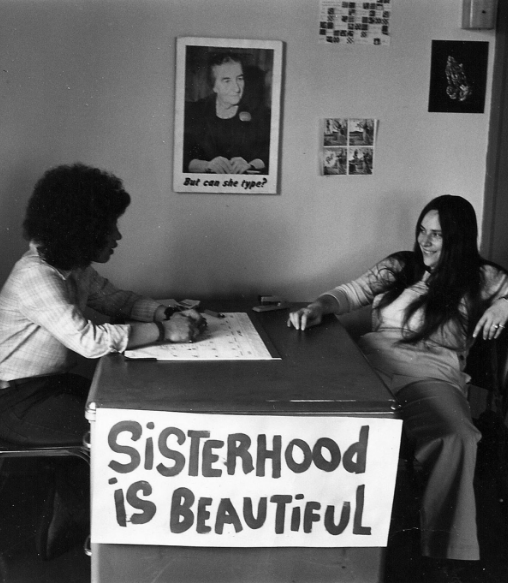For more than a century, ACW’s buildings have been an inspiration to women, their families and the Los Angeles community.

These two homes are located a few blocks south of MacArthur Park—an area once known as Westlake Park and sometimes referred to as Charlie Chaplin’s bathtub (due to the fact that many of Chaplin’s early pictures were made there). Dorothy Maltz, Travelogue of the H.V. Bagwell Co.
The structure located at 1147 South Alvarado Street is significant for its architectural quality and integrity, and its association with a prominent Los Angeles architect, John Paul Kremple. Mr Kremple is famous for building several industrial structures, including engine company number 28 at 644 South Figueroa Street, an inn in Santa Monica, Santa Barbara High School, a sugar refinery, a hotel, masonic buildings in Oxnard and residential homes, such as a home for General Harrison Gray Otis on Wilshire Boulevard, which later became the Otis Art Institute.
The January 27, 1907, issue of the Los Angeles Times indicated that the property owner, Mr. August Winstel, commissioned Mr. Kremple to design the 1147 South Alvarado building. This is a notable example of Kremple’s residential work, as it illustrates his attention to craftsmanship, proportion and detail. A local Pico Union resident, Albert J. Daniels, built the structure, which cost almost $20,000. The building is significant as a relatively unaltered example of Tudor Revival style. It exemplifies the lifestyle of the middle class at the time of the opening of the Palm Palace subdivision. Palm Palace was one of the last subdivisions in the Pico Union area.
The 1147 building draws its inspiration from the English Arts and Crafts movement. The building is highly picturesque with a steep gable roof punctuated by a large gable over a second story bay and two gabled dormers. Half timbering on the second story and in the gables heightens the medieval style of the design. Hedges, palm trees and shrubbery complement this structure, which is set back on a larger corner lot. The first story is of rusticated stone and appears off the porch on the northern portion of the front elevation, extending to the balcony above it. Its wooden railing fills the interstices between the peers on the balcony. On the porch, wooden masonry brackets give the impression of a loggia with flattened arches. The shallow second story bay is slightly cantilevered over the first story on the two beams and is given further definition by a sawtooth molding below it and by exposed beam ends above it.
The interior of the residence contains many decorative elements that are examples of early 20th-century design. The floor plan is relatively open with several large rooms surrounding a central hall with a carved staircase. Several rooms have fireplaces and classical moldings. Original fixtures, hardware and wainscotting remain. Decorative floral reliefs remain on the walls. Several examples of ornate stained and leaded glass are prominent features of the window treatments.
The Turn of the Century
1906
1135 South Alvarado Street, Los Angeles, CA, 90006 was built for the Thomas Potter family. They moved out before 1918. Thomas Potter was born in 1878 in Michigan, and he worked in real estate. Jannie Potter was born 1881 in California. Their domestic servant, Gertrude Fenger, was born in 1885 in Kentucky.
1907
1147 and the Carriage House behind the 1147 building (for a horse and buggy) was built for the Winstel family. They moved out before 1940. August Winstel was born in 1874 and immigrated from Germany in 1882. He worked in real estate. Frances Marty Winstel was born in 1887 in Michigan to German parents. Their daughters, Regina and Bertha, were born in 1901 and 1908 in California. They had three domestic servants, Bridget Hennewsy, born in Ireland in 1868, Bertha Glander, born in New York in 1886, and Hildur Nilson, born in Sweden in 1889.

Changes in Ownership
1926
1135 was owned by August Wohlfarth and his wife, and it was used as a rooming house.
1930
1135 was home to 32 boarders, most in their early twenties, all born in the United States. Half were male and half were female. All were single and white, and most were working white-collar jobs.
1933
1135 was used as a physician’s home/office.
1938
1147 was converted into a “rest or residential” house run by Frances Winstel.
1942
1135 was owned by J.D. Brown and used as a rest home. By 1943 it was owned and run by Mabel Hampton.
1943
1147 was lived in by Lowell and Catherine Craddock. Lowell was born in 1905 in Missouri. He worked as a fruit farmer as well as for General Motors, and he also served in WWII. Catherine was a nurse and manager of the sanitarium/rest home.
1948
1135 and 1147 were both owned by the Craddocks, and the sanitariums were run by Catherine.
ACW Moved In
1974
The Alcoholism Program for Women held their first meeting at 1147 South Alvarado Street.
“We cleaned and painted the house, and while still cleaning a woman drove up and said she would help if they started counseling her right away.” –Carolyn Weathers, founder’s sister and early staff member.
1986
The new owner, Masoud Mansouri, initiated a plan to raze 1135 and 1147 to develop a mini mall.
1987
ACW Executive Director Brenda Underhill organized a grassroots campaign to protect the buildings. Christy McAvoy nominated the buildings as Historic-Cultural Monuments (HCMs).
Over 60 organizations and individuals—including Representative Maxine Waters and Mayor Tom Bradley—sent letters of support. High-profile Angelenas, such as activist Los Angeles City Councilmember Rosalind Wyman, activist and Lesbian Tide founder Jeanne Cordova, Los Angeles School Board member Jackie Goldberg, former California Democratic Party chairwoman Elizabeth Snyder, Assemblywoman Maxine Waters, actress Lily Tomlin, and advocate and Connexxus co-founder Adel Martinez, sat on ACW’s capital campaign advisory to raise funds for ACW to buy the buildings.
On April 13 of that year, the Cultural Heritage Board approved the buildings as Historical Cultural Monuments and the Community Redevelopment Agency CRA/LA began eminent domain proceedings to acquire the buildings. CRA/LA granted a loan to ACW to help purchase the properties.
1988
ACW began rehabilitation of both buildings and renamed 1135 to the Miracle House and 1147 to the Snyder House.
Present
Through ACW’s work, the Miracle House and the Snyder House live on as beacons of hope, transforming lives for women and the community.


